|
One of the original Early
Birds (image of him at this link), William S. "Billy"
Brock landed at the Davis-Monthan Airfield six times between
February 12, 1927 and February 22, 1929. His globe-circling
partner (see images and texts below), Ed Schlee, was his
passenger on October 4, 1928, when they landed in Bellanca J
NX7085. Please follow the airplane's link to learn more about the context of their October 4th landing at Tucson.
Ed Schlee (L) and Wm. Brock, September 28, 1928, San Diego, CA Standing in Front of a Bellanca Aircraft, Probably NX7085
(Source: Kalina)
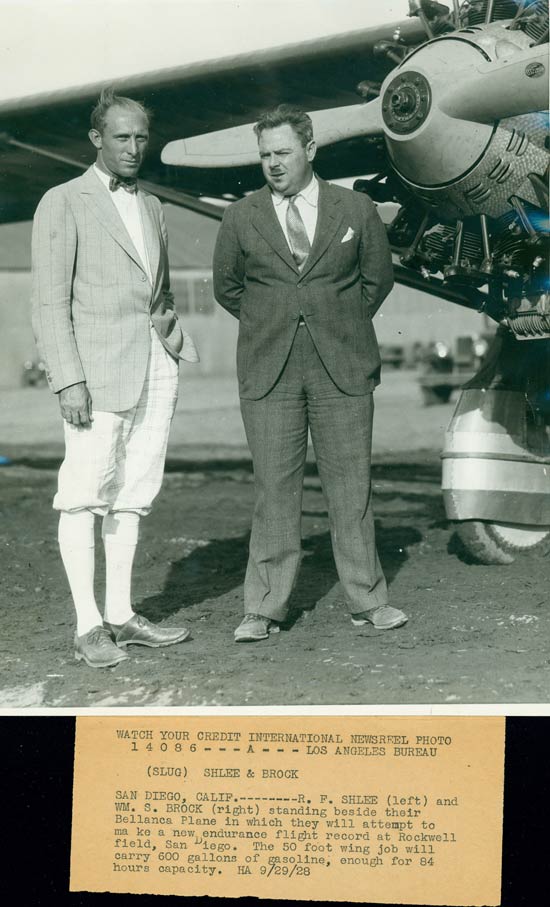 |
Above, from Tim Kalina, an image of Schlee (L) and Brock taken September 28, 1928 in San Diego, CA. Mr. Kalina says of his image, "The Bellanca behind Schlee and Brock has to be NX7085, so in this photo we have a 'hat trick’, three D-M [Register] figures in one photo!" Below, from the Walter P. Reuther Library, Archives of Labor and Urban Affairs, Wayne State University (WSU), is a photograph of Brock and Schlee dated November 2, 1928. Over a dozen images of them together and singly are at the link.
William Brock (L) and Edward Schliee, November 2, 1928 (Source: WSU)
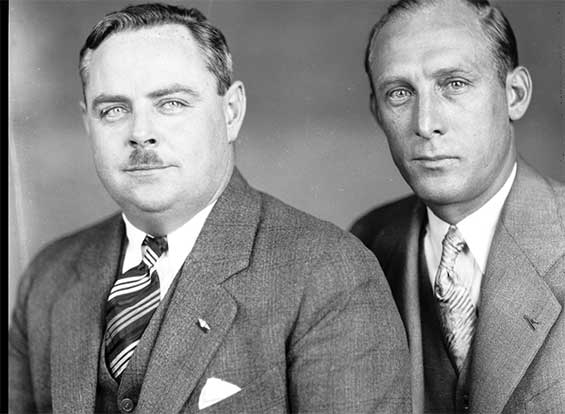 |
Below, an undated image of Brock (L) and Schlee from their NASM biographical file.
Two landings, on February 12 and March 8, 1927, were in an
unidentified Stinson airplane. This aircraft could very well
have been the Detroiter SB-1, #3027 flown in the 1926 Ford Air Tour by Eddie Stinson. Via email, Brock's grandson confirms that it was. May people have contributed the photographs below over the years since this page went online in 2005. My thanks to all of them.
Site visitor M.H. from Kenilworth, England sent the image
below, from his father's collection, taken in Aden (now part of the Republic of Yemen)
in 1927 during the global flight. The Stinson SM-1, "Pride of Detroit",
and the registration number, NC857 (not a Register airplane), on the rudder, are nicely
exhibited. British military personnel crowd around, as well
as a small dog enjoying the shade under the wing.
Another three photographs immediately below, added September 12, 2014, are provided to us by R.D., another site visitor. R.D. states the photos were taken by his wife's great grandfather who was stationed in Iraq in the 1920s. The first image is identical to the one above, with a little less patina. Note the fuel or oil being poured into a tank by the man visible over the wing.
Stinson NC857, "Pride of Detroit," September 2, 1927 (Source: R.D.)
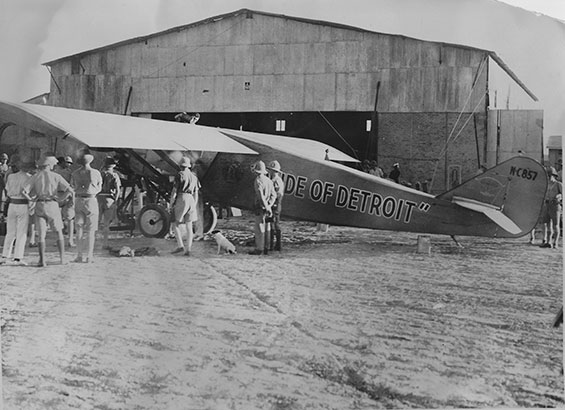 |
Below, the caption on the back of the photo above. It clearly documents key landings during the world flight of NC857, Schlee and Brock.
Stinson NC857, "Pride of Detroit," Caption, September 2, 1927 (Source: R.D.)
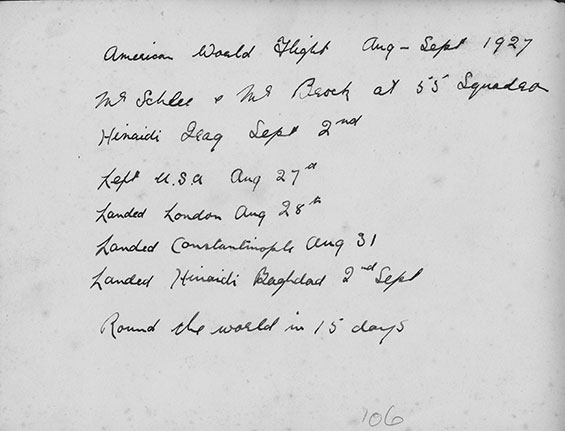 |
Below, an open air maintenance session is captured. It is not clear that this is the same session captured in the photograph next below.
Stinson NC857, "Pride of Detroit," Maintenance, September 2, 1927 (Source: R.D.)
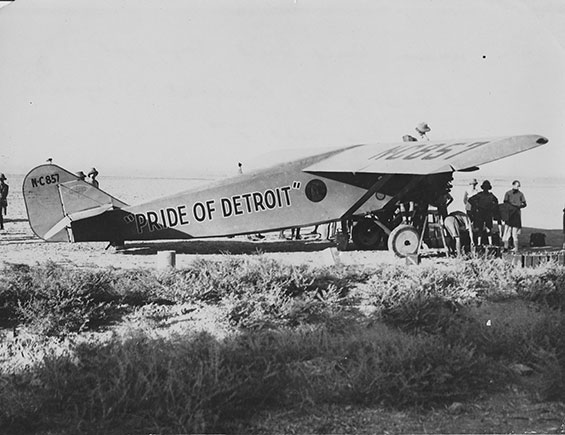 |
Below is a similar photograph shared by site guest D. Hayman on October 4, 2019. She says about the image, "Attached please find the photo of "Pride of Detroit".... It was taken in 1927 by my Uncle William Tomlinson when he was with the RAF. He was also in attendance when Amy Johnson was flying from England to Australia and touched down in Jhansi India to refuel...." Compared to the photo above, the people standing around are in different positions, and there is a two-wheeled tail wheel support in the foreground. But, the two white cans visible in the foregound appear to be the same.
Stinson NC857, "Pride of Detroit," Maintenance, September, 1927 (?) (Source: Hayman)
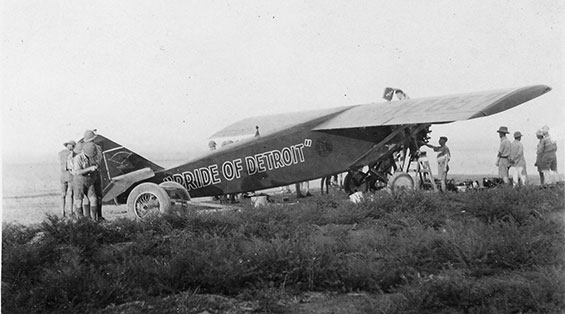 |
Officially, Brock & Schlee's airplane is a Stinson M-2 Detroiter (not
SM-2, just M-2) serial number M-201, built June 20, 1927.
It had a Wright J-5 engine s/n 7556 and was described as a
6PCLM (6-place, Closed, Low-wing, Monoplane) when new. It was sold to Wayco Air Service, Inc., Detroit,
MI (E. F. Schlee, President) for "air taxi service".
Below, three photographs courtesy of site visitor Jackie Crabb. They were taken ca. Sep 6, 1927 when the "Pride of Detroit" was in Calcutta, India. She says about the photographs, "I recently delved into my grandparents photo albums and came across three pictures of Pride of Detroit plane. In 1927 my grandparents were living in Calcutta, India. My grandfather worked for Goodyear. In my research of the Pride of Detroit flight in 1927 I see that it landed in
Calcutta on September 6, 1927. My grandmother is in two of the pictures."
"Pride of Detroit," Calcutta, India, September 6, 1927 (Source: Crabb)
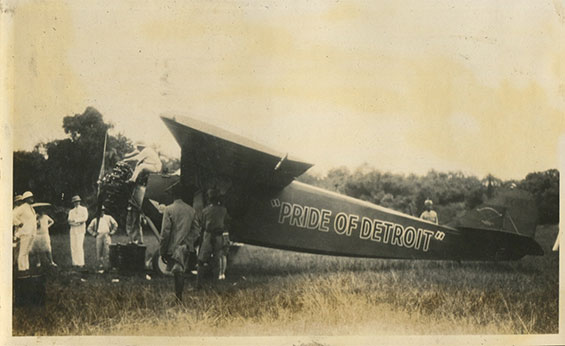 |
Contributor Crabb's grandmother is holding the parasol at left in the photo above. These three photographs were taken by her grandfather, John L. Nicholson.
"Pride of Detroit," Calcutta, India, September 6, 1927 (Source: Crabb)
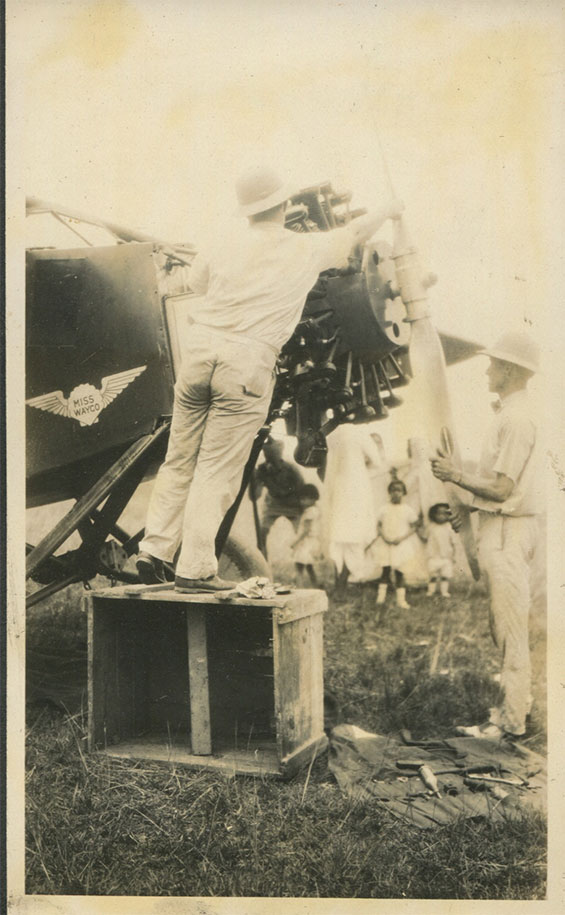 |
The gentleman standing at right, above, appears to be Schlee, and on the box is probably Brock. Notice the canvas rollup tool kit on the ground by the wooden case. I can identify a hand grease gun, a wrench and the head of a ball peen hammer tucked in its pouch next to the grease gun. On the top of the wooden case appears to be a valve rocker arm cover just to the right of the rag. Perhaps they were performing a periodic lubrication of the rocker arms. In the photograph below, Ms. Crabb's grandmother looks at the camera while walking toward the rear of the airplane, parasol over her right shoulder.
"Pride of Detroit," Calcutta, India, September 6, 1927 (Source: Crabb)
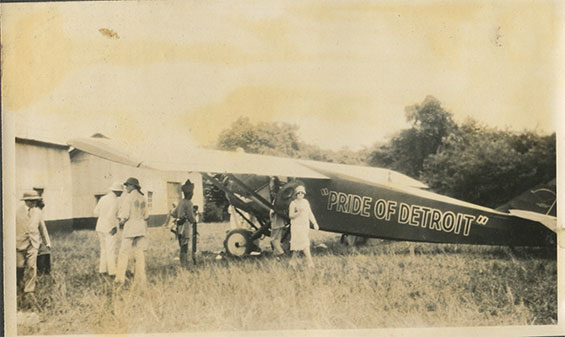 |
Below (added to page February 2, 2010) are two crisp photographs courtesy of a site visitor from England, Vic Flintham. Notice on this first image "WAYCO" painted on the bottom of the starboard wing. The slightly balding gentleman studying a document under the port wing looks like Edward Schlee. The location has been identified by site visitors as Kai Tak Airport, Hong Kong.
"Pride of Detroit" on the Ground, Kai Tak Airport, Hong Kong, Ca. 1927 (Source: Flintham)
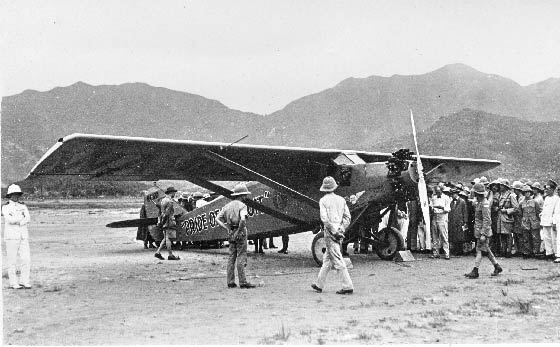 |
We see the "Pride of Detroit" in the air in the next image. From the flight attitude, it appears to be approaching to land. The sign on the building in the background, which probably would positively identify the location, is tantalizingly out of focus.
"Pride of Detroit" on the Ground, Kai Tak Airport, Hong Kong, Ca. 1927 (Source: Flintham)
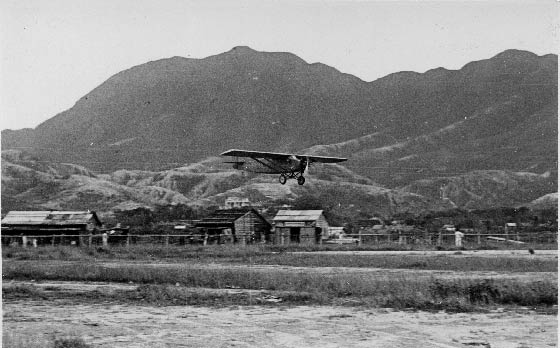 |
Interestingly, the CAA file for NC857 noted that there were "....no papers on
file on the use of the aircraft for a 1927 Atlantic flight
and on to Tokyo, Japan, crewed by Edward Schlee and William
Brock".
Image, above, from the New York Times, shows the airplane in cross-section, with
fuel tanks and navigation equipment installed, as it made
its round the globe flight. There was mention that the aircraft
was named "Pride
of Detroit". On inspection a year later on August 15,
1928, it had the auxiliary gas tanks removed and seats reinstalled.
A letter in the CAA file indicated that it was Schlee and
Brock's intention to place the aircraft in the Ford Museum
in Dearborn. The registration was officially cancelled
December 19, 1929. The aircraft is, in fact, in The Ford
Museum.
Oswego (NY) Palladium-Times, November 21, 1927
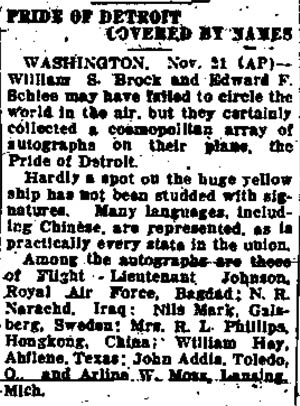 |
At Aden, the airplane, and pilots Brock and Schlee, were
a little less than midway in their round-the-world flight.
Brock and Schlee are not identifiable in the image, unless
the person in the white trousers, far left, is one of them.
This source
states of the pilots, "Reporters remarked that the two
fliers emerged from each stop fresh and smiling, wearing white
summer suits with blue bowties. They could have been a couple
of casual tourists." Under magnification, all the people in the photo appear to be uniformed soldiers.
Brock and Schlee departed on their journey on August 27,
1927. They originally intended their flight to be a world
flight, but they abandoned their attempt, after reaching Tokyo,
Japan, because of poor weather over the Pacific Ocean. After
flying across the Atlantic, they reached Japan, from England,
in eighteen days, flying 145 hours and 30 minutes and covering
12,995 miles. They returned to the United States by ship,
to great accolades in Detroit.
Back in the U.S., as evidenced by the article, left, they had made the "Pride of Detroit" a collector's item with all the autographs acquired during their voyage. Again under magnification, the airplane the airplane does not appear to have any visible writing on it at this point in its journey. Note that the airplane is yellow.
---o0o---
Brock Obituary, Popular Aviation, January, 1933 (Source: PA)
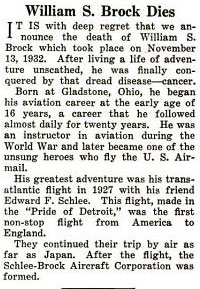 |
Brock died November 13, 1932. One obituary appeared in the January, 1933 issue of Popular Aviation (PA), right.
Site visitor R.R., of Urbana, OH, sent along the following
four newspaper articles published in the Urbana Daily
Citizen in 1945. Thanks to him.
This is a fine link
for William S. Brock. R.R. shared his news articles with
that site also. You'll see them there. This
one is a good link, too. Both links show pictures
of Brock; the latter Schlee.
Parts of the articles below are derived or quoted from other
newspapers, and some of the language is semi-sensational prose.
A fun journalistic vignette.
ARTICLE I
Source: Urbana Daily Citizen Urbana, OH,
July 17, 1945
Headline: Billy Brock, An Unsung Hero Of Early Aviation:
Long Cross-Country Flight Ends Near Urbana
"We recently ran across an article published in a little
Pennsylvania Plant newspaper. It was dated July 12, 1927,
shortly after Lindbergh’s flight across the Atlantic.
We think it is worth republishing now, to draw a contrast
between the pioneer flying during World War No. 1 and the
exact precision of modern flying. But the precision of today
would be impossible without the daring and faith of yesteryear.
The article is also of direct local interest, because the
destination of the flight was Springfield and Urbana, and
because the Billy Brock of the article was born in West Liberty
and his mother lived in Springfield. Here is the article:
“We paid our written tribute last month to Charles
Lindbergh and it is with no thought to belittle his achievement
that we write what is to follow. We know that Lindbergh would
echo a hearty ‘Amen’ to our present toast. That
is: “To the unsung heroes of the air.”
“We are looking back a little over eight years ago,
and there comes to mind another airplane flight. It was made
at the very end of October, 1918, while the war was still
raging. Billy Brock, who was about twenty-two years old, was
an instructor at Park Field in Tennessee, an Army Flying Field.
He had been training other boys to fly, so that they could
go overseas to help win the war. He was so good that they
wouldn’t let him get away from this side of the pond.
“Toward the end of October in the year 1918, there
was no thought or talk in the army, on this side at least,
of any armistice or early end of the war. They planned on
many more months. In fact, at Park Field they were all set
with overseas equipment, as they were at all the other flying
fields. The plan was to leave only a skeleton organization
behind at each field, to pull up stakes enmasse, and establish
an overwhelming American airplane force-in France, to overwhelm
Germany from the air.
“Knowing all of this, Billy Brock wanted to fly from
Park Field to his home in Springfield, Ohio, to say good-bye
to his mother. That was 600 miles away, and in America only
two or three had ever flown a longer distance, and no one
had ever flown nearly that distance in a Curtiss Jennie. But
Billy had been flying since he was 15 years old, and he was
good. So, the commanding officer gave him permission to make
the flight. He was to take another Army officer along as a
passenger. The ship chosen was one of the first type of Curtiss
training planes, a J.N.4-A, with a Curtiss O.&.5 [sic]
motor. It was the only J.N.4-A at the field. They were then
using J.N4-D’s, an improvised type of plane. All the
other J.N.4-A’s had been junked, and this one had been
put out of service. Being out of service some of the boys,
in their spare time, had taken the controls out of the front
cockpit and had built in a 20 gallon gasoline tank instead
of the usual 10 gallon tank. That was the reason that Billy
selected this discarded ship -because it could carry more
gasoline. But it had this disadvantage-the installation of
the larger tank had necessitated the removal of all the instruments,
they being on the front dash, so the ship had no compass,
no altimeter, no wind-drift indicator, not even a gasoline
or an oil gauge. Its maximum speed was about 75 miles an hour,
and its ceiling was about two thousand feet.
“At daybreak on a Friday morning, the ship was ‘on
the line.’ No other ships were out, because the fog
was so bad you could not see 50 yards ahead. Flying had been
called off for the forepart of the morning, and the only people
on hand besides Billy and his passenger were their wives,
a couple of hanger-men, and Red Thompson, a buddy of Billy.
The passenger climbed into the front seat and fastened his
safety belt. Billy walked around the ship a couple of times,
then climbed in and strapped. Red Thompson told Billy what
a fool he was to take off in such a fog. Billy replied in
proper Army repartee, and then Red handed Billy a horseshoe
and a rabbit’s foot. These two buddies, who both came
from Springfield, and who had flown together for years before
the war, had several times handed back and forth these same
charms."
ARTICLE II
Source: Urbana Daily Citizen Urbana, OH,
July 18, 1945
Headline: Billy Brock, An Unsung Hero Of Early Aviation:
Long Cross-Country Flight Ends Near Urbana
"At conclusion of Tuesday’s installment- the first
of a four part story- Billy Brock, accompanied by a pal from
Springfield, Ohio, were about to take off in an outmoded army
plane for a cross-country flight from Tennessee to Urbana
and Springfield.
" Enshrouded by heavy fog, with no navigation instruments
to guide them, the two flyers gambled their destiny on a horseshoe
and a rabbit’s foot which they had decided to take along
as good luck tokens.
The story continues: “The ship took off. The fog was
so thick, it was sticky. Nothing could be seen, and they had
no altimeter, but they could tell by the feel that the ship
was climbing all right. In less than 20 minutes the ship came
out of the fog into clear air, which would have been a relief,
except for the fact that there was no sight of ground in any
direction, nothing but dense banks of clouds underneath. They
had no compass and no chart-only a six-inch pocket map of
Tennessee and Kentucky. Billy had planned on following the
Louisville and Nashville railroad, but they couldn’t
see it. The sight of the sun helped little, as there was a
side to rear gale blowing, which might have been 30 miles
an hour or it might have been 60. But they had no means of
telling its strength or its directions, as they had no wind-drift
indicator. It was afterward learned that it was over 50 miles
an hour.
“They flew above the clouds, without a sight of the
earth, for a couple of hours, without knowing whether their
altitude was two thousand or five hundred feet. Finally, Billy
called to his companion: “We ought to be about over
Paris (Tennessee); I’m going to cut down and find out.”
He started a tight spiral, but in less than a minute he almost
jerked the plane apart, coming out it took away some branches
out of the top of a tree, missed a couple of buildings by
less distance than was comfortable, and found that he was
squarely over the heart of Paris, Tennessee. It hadn’t
been clouds he had been flying over, it was clouds and fog
right down to the ground.
“Billy Brock had flown for two hours with no sight
of the ground, no compass, no instruments of any kind, and
with a terrible side-tail wind of unknown strength or direction.
And he not only guessed, he knew, within less than a mile,
exactly where he was. How did he know it? You have learned
how cats know their whereabouts. Perhaps it was something
like that, only more marvelous, as this was all done in the
air.
“Well, Billy got his ship flattened out, and was again
on his way. It wasn’t long until they left the clouds
and fog, and were over Kentucky. Worry about gasoline supply
advised a landing, and they landed in a stubble field at the
edge of the town of Russellville. We will omit some of the
details of the take-off from Russellville. In that take-off
they came nearer death than at any time on the flight. It
was a matter of inches several times-a short, soggy field,
loggy gasoline, a nose-heavy ship, telephone wires straight
ahead, a zoom over the wires that anyone would have said was
impossible, a vault over some more wires and a railroad track,
a gliding squash into a soft field across the track, but with
enough headway to keep going and to finally climb fifteen
feet in the air, but with a house straight ahead. There wasn’t
time or altitude to turn, so Billy went straight for the house,
and just as he came to it, he threw the ship into a vertical
bank, one wing missed the chimney by not more than a couple
of feet, and the other wing came that close to the ground,
but they cleared the house.
“They finally gained altitude, and it was straight
and clear flying over the edge of the mountain district of
Kentucky. That is the country that, form the air, has nothing
underneath for well over a hundred miles but mountains, forests,
snake-like rivers, small clearings and intermittent small
lakes and ponds. A forced landing would have meant the tree
tops.
“They landed near Louisville for the night, took off
the next morning in a blinding rainstorm, tried to get above
the rain, but the higher they went, the more it was sleet
instead of rain. They kept on toward Cincinnati, got out of
the storm, then turned north, did some stunts over Springfield,
and then landed on the golf course of the Springfield Country
Club. They had lunch with Billy’s mother, then took
to the air again, and landed on a farm just west of Urbana,
where the passenger had relatives.
“Billy Brock, twenty-two years old, had resurrected
a J.N.4-A out of the junk pile, and had flown it, with no
instruments and with nothing but genius to guide him, in bad
weather, over a wilderness country, and part of it was blind
flying; then, he turned around and made the return trip, which
was even worse, because the wind was against him.
“Billy Brock didn’t get overseas, because they
kept him on this side. Few people have ever heard of him.
The last we heard of him, about four years ago, he was taking
up passengers for five dollars an hour, when he could get
the passengers. He is unknown to fame, but he was one of the
pathfinders in aviation. He is an unsung hero.”
ARTICLE III
Source: Urbana Daily Citizen Urbana, OH,
July 19, 1945
Headline: Billy Brock, An Unsung Hero Of Early Aviation:
Around-the-World Flight Ends in Japan
"In Wednesday’s installment we reprinted an article
written in July, 1927 about Billy Brock’s airplane trip
from Tennessee to Springfield and Urbana during the World
War No.1. When that article was originally written, no news
had been given out as to Billy’s plan to fly around
the world. He made that world flight in the late summer of
1927, and that same Pennsylvania plant newspaper had an article
about it in its issue of Oct. 12, 1927. Here is the article:
“In our issue of July the twelfth we printed an article
which was entitled: ‘Unsung Heroes of the Air’.
We were inspired to write that by Lindbergh’s ocean
triumph. When we printed that article we had no idea that
Billy Brock had intended to try what he has just done. You
will remember, we wound up our article of July the twelfth
by the statement that the last we heard of Billy Brock, he
was taking up passengers at a modest fee.
“Well, you must have read about the around-the-world
flyers, who started out to fly around the world, and who got
as far as Japan-Brock and Schlee. The Brock who flew this
airplane is the same Brock of whom we wrote. He is about thirty-two
years old, and is a courageous, but an exact and careful flyer.
“Here is what the Pittsburgh Post-Gazette said about
their flight in the editorial column of August 20th, the morning
after they had landed in England:
“The successful negotiation by William S. Brock and
Edward Schlee of the first leg of their projected around-the-world
trip by air, completing the first non-stop trans-Atlantic
flight from America to England naturally raises hopes for
the achievement of their entire object. They are seeking to
beat the globe-circling record of twenty-eight days, fourteen
hours and thirty minutes, made by Edward Evans and Linton
Wells last year by utilizing steamer, railroad, automobile
and airplane; Brock and Schlee, depending wholly upon their
monoplane, Pride of Detroit, expect to make the trip in twenty-eight
days or less. Their covering the 2,350 miles from Harbor Grace,
Newfoundland, to the airport at Croyden, England in twenty-three
hours and twenty minutes is a good start on their schedule.
The extraordinary thoroughness with which this trip was planned
gives a practical interest to it along with that which may
be merely of the thrill type. Schlee, the backer and Brock,
the pilot, had been at work on the preparations for a year.
With the mapping out of their course, there was also provision
over the route of fuel and service stations. The Pride of
Detroit was built with the same care, and tested. It won by
a large margin the Ford trophy against a field of fourteen
specially prepared planes in a 4,200 mile test. The total
mileage of the course in this undertaking is 22,067, with
a total of 240 hours allowed for flying. However the object
of the trip may be viewed, the thoroughness of the preparation
for it meets the growing demand against recklessness in setting
out on air journeys involving long flights over water’
“Brock and Schlee flew no further than Japan, and abandoned
their trip there, partly because there was no gasoline supply
at the Midway Islands, their next objective, and partly because
of the hundreds of cablegrams they received begging them not
to try to fly across the Pacific Ocean, including a ‘request’
from President Coolidge. They realized that after the large
number of deaths in attempting ocean flights, an accident
to them would retard the progress of aviation. And they were
more interested in the development of aviation than they were
in any personal triumph. But at least they demonstrated that
hard work, studious preparation, and careful courage and determination
are essentials to successful flying.”
"This is the same Billy Brock who was born in West Liberty,
raised in Springfield, and who began flying before he was
sixteen years old. In a later account, we will tell you something
about how Billy learned to fly."
ARTICLE IV
Source: Urbana Daily Citizen Urbana, OH,
July 20, 1945
Headline: Billy Brock, An Unsung Hero
Of Early Aviation: West Liberty Boy Began Flying When Eleven
"(EDITOR’S FOREWORD: These stories concerning
the career of Billy Brock, the West Liberty boy who helped
pave the way for modern aviation, were prepared by one of
his close personal friends and Army air corps associates Attorney
Edgar W. Tait, 403 Scioto Street. It was Tait who, as post
adjutant at Park Field, Tennessee during World War I, awarded
Brock the lieutenant’s commission which transformed
him from a civilian army flying instructor to a full fledged
military pilot. The commission was awarded at Wright Field.
"Since then the two men maintained a close personal
friendship visiting one another whenever possible. Their last
meeting was in Pittsburgh shortly before Brock’s death.
"In the past three articles, we have written about Billy
Brock of West Liberty and Springfield. We would like to tell
you something of this boy’s craving urge to fly, and
of his flying education. Some of these facts were proddingly
picked out from Billy, for he was not much of a talker about
himself. Some of this story was furnished by others who knew
him. Here is the story:
"The story starts at West Liberty, when Billy was eleven
years old. The Wright Brothers had made their Kitty Hawk flight
a few years before. They had conducted their experiments at
an historic place between Springfield and Dayton. That part
of Ohio was already air-conscious, and Billy began to think
of nothing but flying. He started to work, building a pair
of wings. He used whatever sticks he could pick up around
the neighborhood. He managed to beg a couple of old sheets
from his mother, for the wing fabric. Finally, the wings suited
him. He strapped them onto his arms, climbed to the top of
his father’s barn, and jumped off. The experiment was
not entirely a success. He glided a few rods, the wings smashed
on the landing, but he broke no bones.
"Four years later, when he was fifteen years old, Billy
heard about Glenn Curtiss’ flying school at Hammondsport,
New York. He had a little money saved, just enough to pay
his railroad fare there, so off he started for Hammondsport.
He walked into Glenn Curtiss’ office, and said he had
come to learn to fly. Glenn Curtiss asked him how old he was
and he replied, “Eighteen.” He was well developed
for his age, so he got away with that. Then Curtiss said:
“The tuition will be $150.” Billy said: “Why
I never thought about you charging for teaching, and I don’t
have that much money.” Curtiss said: “How much
do you have?” and Billy answered, “Sixty-five
cents.” Curtiss said: “Well, you had better write
to your folks for enough money to get home. In the meantime,
we can’t let you starve. I’ll let you help the
cook in the kitchen, to pay for your board until you hear
from your folks.”
"So, Billy went to work in the kitchen. But it was okay
for Billy to make friends, and he was soon chummy with the
flying instructors. He coaxed one of the instructors to take
him up, and before they had landed, Billy was getting some
flying instruction. He went up every day, and in less than
a week he was soloing-all unknown to Glenn Curtiss. Not satisfied
with this, Billy put in another week of learning every stunt
the instructor knew. Finally, the instructor said, “Kid,
you are as good as I am.”
"Then, Billy walked into Glenn Curtiss’ office
again-the only time he had been there since his first arrival
visit. He had made a point of keeping out of Curtiss’
way. Curtiss looked up from his desk, and said: “What,
are you still here? Well, what do you want?” and Billy
replied: “I want a job as an instructor.” A queer,
startled look appeared on Curtiss’ face, and Billy said:
“No, I’m not crazy. One of the instructors has
taught me. Come out and watch me.” Curtiss asked the
instructor, and he said: “Yes, I guess I shouldn’t
have done it behind your back. But the boy is a born flyer.
He is good.” So, Billy took the ship up, put it through
its paces, spun it, looped it, did every stunt that was then
known, and finally made a perfect landing. Curtiss said: “Take
me up and do it all over again.” When they landed, Billy
Said: “Mr. Curtiss, do I get the job?” and Glenn
Curtiss replied: “You do.”
"So, in the year 1912, at the age of 15 years old (although
he stuck to his 18 years of age story), Billy became a flying
instructor. He continued as an instructor and stunt flyer
until we go into the war in 1917, when he became an army flying
instructor. There, his finished students were as many as those
turned out by any other instructor, and when he said they
were ready for their wings, they were ready and they were
good.
"We have told, in previous articles, about Billy’s
career after the war, how he barnstormed, took up passengers,
instructed, and finally flew across the Atlantic, across Europe
and Asia, to Japan. In the issue of March 29, 1928 of the
Pittsburgh Sun-Telegraph, Havey Boyle, sports writer and columnist
wrote the following:
“He is between 35 and 40, of medium height, and inclined
to heaviness. His hair shows a streak or so of gray. A short
mustache is becoming. His eyes are clear blue. He achieves
neatness in dress without showing any signs of study in this
regard. He has a naturalness-a mixture of justifiable pride
and becoming modesty. His name is Billy Brock-and all he did
was to fly across the ocean with a partner-Eddie Schlee. You
remember how we read of their hop-off, of the anxious while
they rode through the night through the fog and ice, and how
at last they landed safely on the other side.
“Billy Brock was in Pittsburgh to attend the airplane
show. He is now a salesman, selling the kind of ship he and
Schlee used in making their historic flight. I have been close
(I mean close in the sense of feet and inches) to such gentlemen
as Dempsey, Ruth, and Tunney and a few others, but I never
got quite the emotional thrill from such propinquity as I
got out of studying and talking a few moments with this youngish
Billy Brock, who defied death successfully in a flight across
the ocean.
“By now his story is an old one. He took off when three
other planes were making ready. Two of those planes and their
occupants were lost. The third didn’t get very far before
it was forced to land, a failure. There were moments, Mr.
Brock said the other evening, when he couldn’t help
but feel that the venture was going to lose-those periods
when there was nothing but ice and fog to cut through. But
it was not his story, so much as the fact that here was a
man in good health who had stepped into a plane to take a
ride with death. I thought, too, as he talked, of how many,
many centuries from now his name and picture will be in the
history books and encyclopedia. There is a kick to being so
close to a man of-consider this-timeless and endless fame.
"So wrote Havey Boyle, sixteen years ago.
"Billy was never injured in flying, nor was any of his
passengers. He never had a crack-up that cost more than a
ripped wing or a splintered landing gear. Army officers, up
until the time of his death, said Billy was the most careful,
the safest, the most scientific, and yet, when necessity required,
the most daring flyers our nation had yet produced.
"Billy died of cancer a little more than twelve years
ago [in 1932]. He was flying until a month before his death."
A final photograph of Brock and Schlee's global flight Stinson , courtesy of Guest Editor Bob Woodling, is below. The registration number is distinct. The exact date and location are unknown.
Stinson SM-1 NC857, Date & Location Unknown (Source: Woodling)
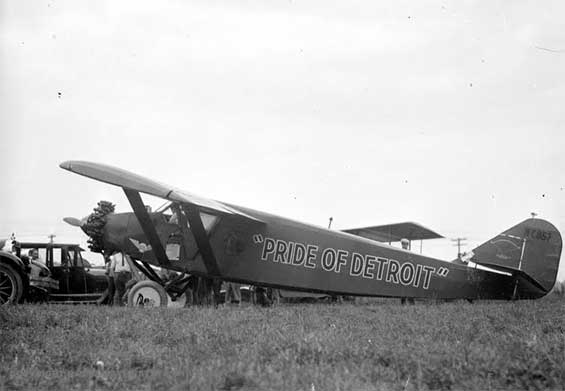 |
---o0o---
Dossier 2.1.56
THIS PAGE UPLOADED: 06/13/05 REVISED: 07/07/05, 01/16/06, 01/18/06,
03/27/06, 12/31/07, 08/29/08, 02/02/10, 03/21/14, 06/25/14, 09/12/14, 09/13/15, 07/13/17, 10/05/19
|
